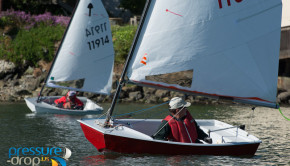An Aloha Family Tradition
Published on August 13th, 2019
by Tom Burden
Kui Lim and his brother Yal campaigned 470-class dinghies at the Olympic level and trained with Dave Ullman. JV Gilmour races 18-foot skiffs at insane speeds while his mom Vickie, a respected US Sailing judge, lives on the water with a Grand Banks cruiser tied to the dock outside her house.
Buzz Blackett is the owner of California Condor, a bleeding-edge Class 40, and he’s got a carbon Antrim 27 under construction. As for me, I’m the owner of a restored Cal 40, though perhaps I could say that Shaman owns me and that I count myself among the “boat poor”.
What do we have in common? We’re all El Toro sailors.
We competed as adults in the 2019 El Toro North American Championships, which challenged us all on the breezy, coral-lined waters of Kaneohe Bay, Hawaii. As our sore muscles heal and our sunburned malihini (mainlander) skins peel, it’s worth looking back at the intense racing, and pondering the continuing successful survival of this humble 8-foot pram.
Our class was born in Richmond, California in 1938, as members of the then-new Richmond Yacht Club engaged in a “bull session,” with the intent of modifying Rudder Magazine’s plans for a build-it-yourself plywood dinghy called the McGregor Sabot. Brilliant design enhancements followed: a foredeck, a mast with a bolt-rope slot and a halyard, and best of all, a removable wood daggerboard.
After 1945, this high-tech East Bay rocketship really took off, evolving to embrace fiberglass boats in the ’60s, cored hulls and carbon fiber masts in the ’90s, to reach the current state of refined elegance that is our twenty-first century El Toro. Some of us jokingly refer to it as the Ferrari of prams!
Over the decades, some 12,000 hull numbers have been issued by the El Toro International Yacht Racing Association.
The only problem with this state of evolutionary perfection is a brick-shaped disruptor from Florida called an Optimist Pram, aka the Opti. Add a few younger foreign invaders like the French O’pen Skiff and British RS Feva, and many yacht club junior programs have reconsidered the El Toro in favor of cheaper, generic, injection-molded or roto-molded alternatives.
Yet the El Toro endures.
So does the Sabot, our Southern California cousin dinghy born of the same Rudder Magazine plans. With 187 Sabot sailors of all ages turning out recently for San Diego Yacht Club’s 2019 Dutch Shoe Marathon, it’s clear that these two boats, the El Toro and the Sabot, offer something unique–an affordable, simple racing sailboat for all ages.
At our North Americans, the Lim brothers, decades removed from Olympic campaigning, squared off in the Senior Fleet, brother racing brother. Baby boomer parents like Vickie Gilmour raced their millennial children, and former sailing instructors matched up with their ex-students, youth proving superior to age in most cases.
The daily racing schedule called for the Junior Fleet (under age 15) to begin racing at 10:30am, with the Seniors first warning horn at 2pm. This allowed parents like Chris Sullivan to spectate from the clubhouse or a pontoon boat, watching his son Evan sail in the gentler morning trade winds, before suiting up for the full afternoon pressure of 15 to 20 knots.
Championship El Toro racing on Kaneohe Bay is a long-celebrated family tradition. Old-timers remember coming over from the Mainland in the ‘50s, while younger folks reminisce about racing as a Junior in 1992 or 1997.
This year, mainland racers shipped a 40-foot Matson container from Oakland, CA full of 17 El Toros. Our hosts, the Kaneohe Yacht Club, added extra excitement by creating a virtual El Toro Race Week, rescheduling two marquee regattas, the Hawaii State Championship and the Hawaii Bullship Race, to be held in advance.
Nearly all the mainlanders raced all three events, with a three-day gap in between for touristy, Mai-Tai-drinking, poolside-lounging, shaved-ice-eating satiation. By the time we boarded our airliner for the return to Northern California, we’d enjoyed 11 to 25-knots of El Toro action, plenty of hulis (capsizes), and a total of 13 races.
The Junior Fleet shook out as a two-way battle between Richmond YC’s Chase Englehart and Kaneohe YC’s 11-year-old Makani Andrews. These two talented young sailors showed dominant speed and boat-handling all week, with Makani scorching the fleet in the Bullship Race. In the main event, these two battled to the final race, which Chase won to become the first mainlander in 22 years to defeat the Hawaiians on Kaneohe Bay, becoming the 2019 Junior North American Champion.
In the 28-boat Senior Fleet, the talent level was formidable, with Olympians, college sailors, sailing instructors, and athletic, well-coached teenagers making a top ten finish a real accomplishment. The podium of the fleet was an all-Hawaiian showdown between Kui Lim and Jesse Andrews (Makani’s father, KYC Sailing Director and University of Hawaii Assistant Sailing Coach).
A 12th place finish by Andrews in race five, followed by a mental error in the final race, handed Kui Lim his record 10th El Toro Senior North American Championship. Young Max Roth was third, followed by Michael “Blackbeard” Pacholski and Morgan Vodzak, who was also the top female finisher.
All of the mainland Toro racers owe a big Mahalo to the Richmond Yacht Club Foundation, Matson Lines, the Kaneohe Yacht Club volunteers, and especially to Buzz Blackett and KYC’s Kim Ickler, who did much of the tireless organizing so we could sail. Toro! Toro! Toro!








 We’ll keep your information safe.
We’ll keep your information safe.